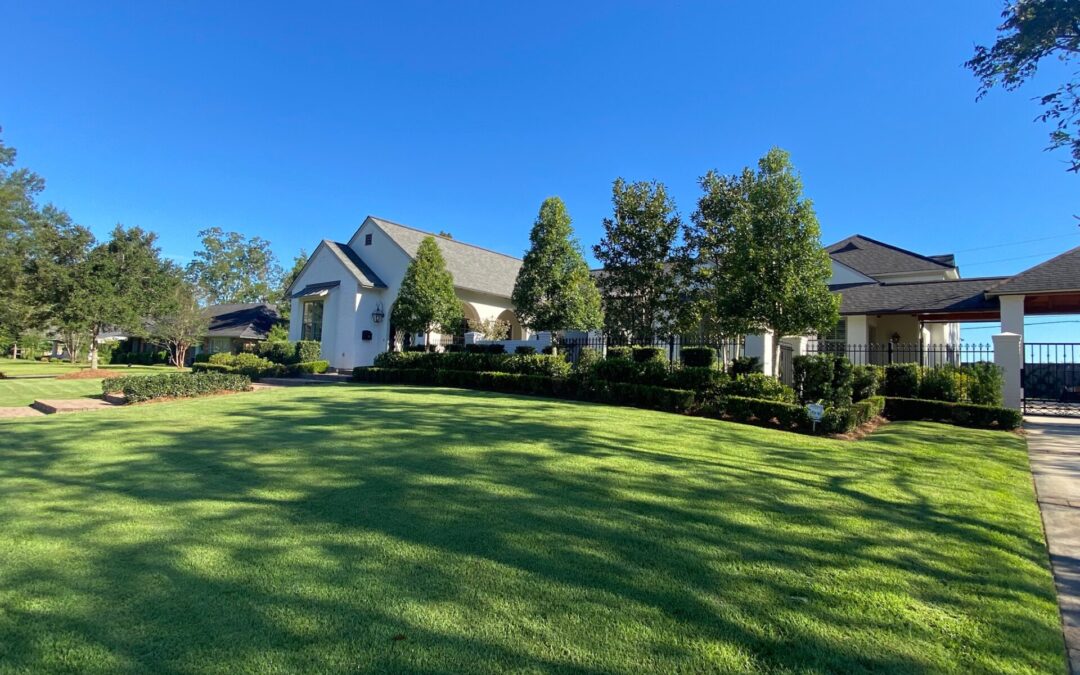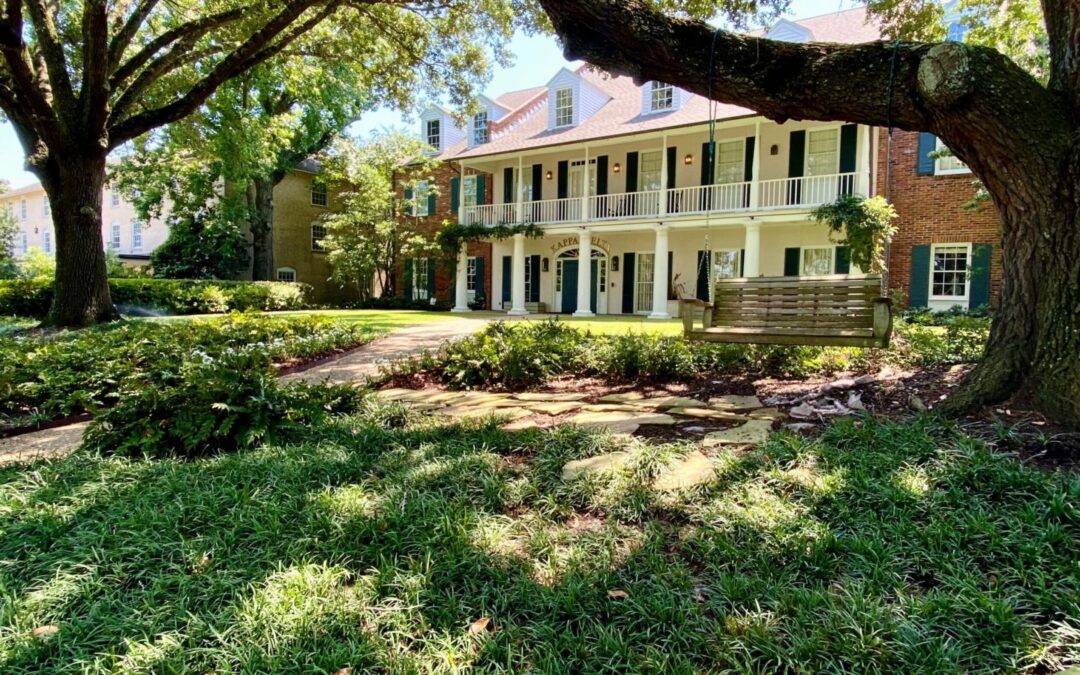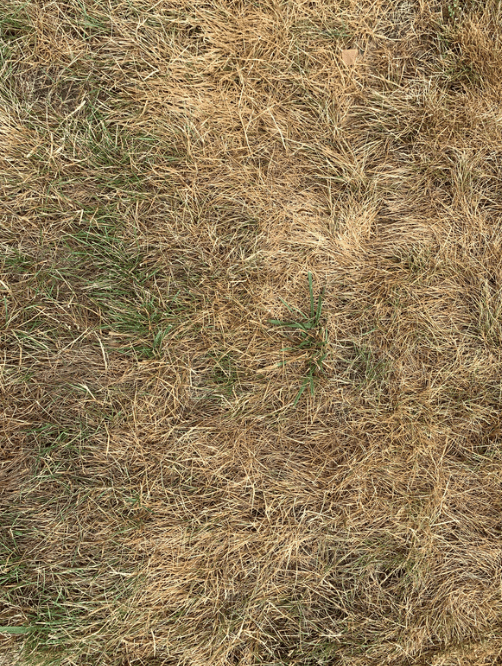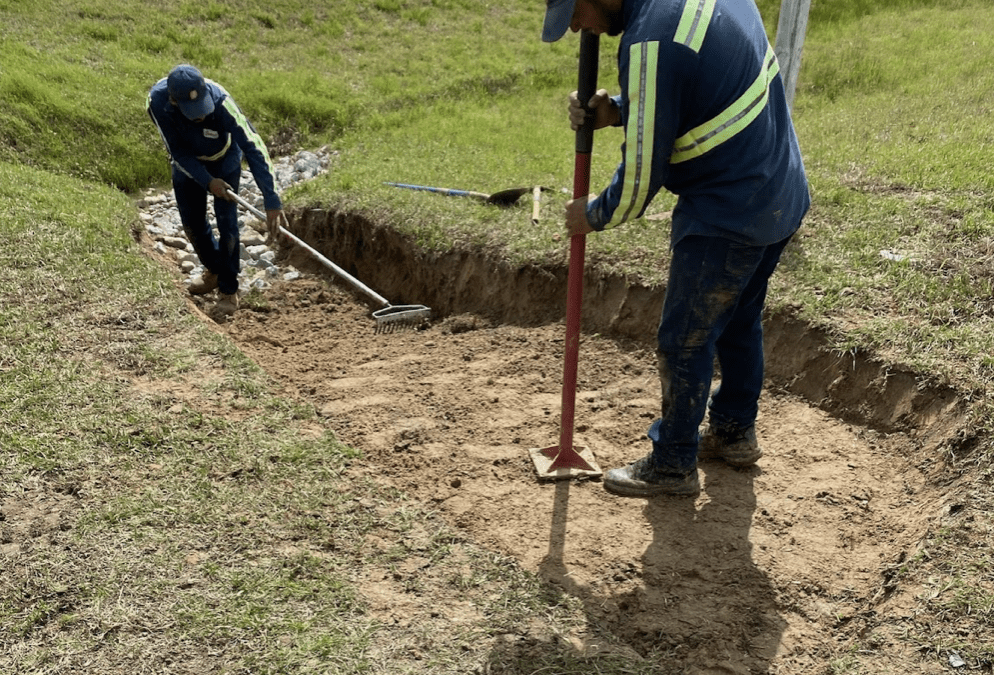
by leesonlandsca1 | Aug 17, 2022
Warm season grasses are the lawns of choice for many Baton Rouge properties because they flourish when the temperatures are high and go dormant when temperatures start to drop. This keeps them looking great for the majority of the year.
Although warm season grasses will be relatively low maintenance in the winter, without the need for mowing, watering, and other regular tasks, there is still some maintenance required and you should start prepping your warm season grass in the fall to keep turf healthy and ready to come back in the spring.
Fall Lawn Care Tips
As long as temperatures are high enough that your lawn is growing, you should continue your summer lawn care strategies. But when growth begins to slow, you will want to transition to the following steps:
- Fertilize One Last Time – Your grass needs to go dormant at the right time in order to be able to get through cold weather. For this reason, you want to stop fertilizing approximately 6 weeks before the first frost in mid-November.
- Mow Your Grass – You can safely mow your grass for as long as it is growing, but as it gets later in the season, set the blade on your mower slightly lower to get grass into its shorter overwintering state.
- Pick Up Leaves – Fallen leaves on your lawn leaves can be suffocating and harbor pests and fungi. Rake up leaves regularly or mulch them by going over fallen leaves with your lawnmower.
- Perform Weed Control – Grass that is shorter and turning brown will make it easy to spot weeds that may have started growing during the summer. You can pull weeds as you find them or use a post-emergent herbicide to get rid of them.
Another option for fall lawn care includes overseeding. This is one way to maintain a green lawn in the winter. With this strategy, you will scatter cool season grass seeds as soon as your warm season lawn begins to turn brown, and those seeds will start to grow once temperatures cool. Ryegrass is a good option here. Water your grass regularly as it becomes established and continue to water, mow, and fertilize throughout the winter to keep the cool season grass healthy.
Leeson Landscape is a landscape company and our lawn care in Baton Rouge is one of the best ways to get your yard ready for winter. Whether you want to maintain it in a healthy dormant state or overseed for a year round green lawn, we work with residential and commercial properties in Baton Rouge to help our clients achieve the healthiest and most beautiful turfgrass. Contact us to learn more about our lawn care services.

by leesonlandsca1 | Aug 11, 2022
Although there are still several more weeks of warm weather in Baton Rouge, now is a great time to begin planning your fall and winter landscaping. Many plants that will thrive in Baton Rouge in the winter need to go into the ground early in the fall to truly look their best. Taking the time to plan out a winter landscape now will keep your home or business looking vibrant even as grass and summer flowers start to turn brown and die off as cooler weather approaches.
Winter Flowers to Plant in the Fall in Baton Rouge
Although summer is often considered the best time for flowers, many blooms do best in Baton Rouge in the winter, particularly in the warmer local climate. Some of the flowers you could consider planting this fall includes:
- Geraniums
- Pansies
- Carnations
- Violets
When planted from seed, these flowers will begin blooming later in the fall and can continue to flower throughout much of the winter, especially if you provide regular fertilization and trim off any blooms that are starting to wilt. If you are planting seedlings or established flowers, they can go in the ground a little later in the season.
Fall and winter are also the best times for planting several varieties of trees and shrubs in Baton Rouge since the cooler temperatures make it easier for these plants to become established before they endure the heat. But you do still need to be aware of the potential for cold snaps that could put too much stress on new plants. Those that thrive in cooler temperatures and will generally do well planted in the winter include shrubs and trees like:
- Azaleas
- Magnolias
- Willow Oaks
- Vytex Trees
- Hydrangeas
- Camelias
One of the best ways to be sure that you have beautiful fall color at your property is with seasonal color changeouts from Leeson Landscape. For many of the properties we work with, we can plant fall-ready flowers that will offer beautiful blooms and colors to keep your property looking beautiful all year long. Contact our team for more information on our year round landscaping services in Baton Rouge.

by leesonlandsca1 | Aug 5, 2022
New plants are most delicate in the weeks immediately following planting. During this time, they are establishing their roots, a process that requires them to have ample water and the right growing conditions.
This is especially important for trees, which are often a significant investment in your landscaping, and you want to be sure you are providing the right care so that the tree will grow a strong root system and be healthy for many years to come. The health of your tree begins with the correct watering schedule.
Determining the Best Watering Schedule for New Trees
How often and how much you should water a sapling depends on the type of tree, its size, where you plant it, and other weather conditions. In general, you should water any tree within a few hours after planting it, and then water the tree daily throughout the first week. At this point, the tree will be slightly more established and should be able to go about a week between waterings depending on the weather.
The amount of water you need to use will depend almost entirely on the type of tree. For most trees, several gallons of water is often required. The best way to do this is to water slowly to give the water time to absorb into the soil below.
To give you an idea of watering routines, these are the water requirements for a variety of trees that grow well in Baton Rouge:
- Meyer Lemon Trees – These are smaller trees that are both ornamental and provide the benefit of fresh lemons. You want to water lemon trees once a week so that the soil around the tree is kept moist, but should not be flooded. These trees also need weekly waterings throughout their lifetime.
- Spruce Pine – A spruce pine fully grown can be up to 60 feet tall, making for an impressive tree at Baton Rouge properties. A new spruce pine should be watered throughout the first year to keep the top inch of soil moist. After a year, a spruce pine is often established enough to survive on its own with just rain.
- Crepe Myrtle – A crepe myrtle is about 20 feet high with beautiful pink blossoms in the spring. They need weekly watering in the beginning. For each watering, you should plan to water slowly for about an hour to get the tree the amount of water it needs.
These guidelines are for trees planted directly into the ground. Trees in pots have slightly different requirements and will not need as much water since the water will be contained in the pot. This may mean that even for new trees, you will not water every day. Instead, water anytime at the top 2 inches of soil in the pot feels dry, and continue to water until you notice water draining from the bottom of the pot.
While your tree is becoming established, pay daily attention to it until you get a feel for how weather, the amount of shade and sunlight, and other factors are affecting how quickly it dries out. This ensures that you have a beautiful tree for many years.
Leeson Landscape is a Baton Rouge landscaper and landscape maintenance company that you can also rely on for tree planting services. Whether we are helping you establish your landscape or keeping new plantings thriving with our ongoing landscape maintenance services, we will keep your yard looking its most beautiful. Call us to learn more.

by leesonlandsca1 | Aug 1, 2022
A beautiful lawn with thick and lush green grass is a great feature of any property, so it can be especially frustrating when your lawn seems to be dying. This could mean you are seeing small areas of yellow patches or your entire lawn may seem to be going brown.
The first step in fixing this issue is to identify the problem to determine what corrective steps to take to keep your lawn growing well.
Common Reasons Lawns in Baton Rouge Start Dying
Although there can be a number of reasons why your lawn starts to die, some basic observations are often enough to help you pinpoint the cause which can include:
- Not Enough Water – With Baton Rouge’s frequent rain, this is rare but not impossible. Lawns that are not receiving enough water will often be brown and straw like. If only parts of your life lawn are like this, chances are it is a sprinkler problem. If your entire lawn is dry, a deep watering followed by regular watering is likely necessary.
- Excess Water – When lawns get too much water, the grass will not be able to get enough oxygen and the soil temperature will become too cold for grass to grow. If you suspect your lawn is getting too much water, you can cut back on your watering or schedule water in the morning so water can evaporate. But you should also make sure that you have effective drainage in place.
- Pests – Cinch bugs beetles and other pests can damage the roots of lawns in Baton Rouge and cause grass blades to become brown and wilted in appearance. The solution will depend on the type of pest, although pesticides can often help, as well as changing the way you water your lawn.
- Weeds – Weeds growing in your lawn will keep grass from getting enough nutrients and water, eventually causing the grass to begin to turn brown. Like pests, you will need to know which type of weed you have in your yard to apply the correct herbicide treatments.
- Disease – Different fungi and diseases can infect your grass and cause damage to roots or blades. Although there are several different types of fungi that can occur, common ones include mushrooms that create fairy circles, or patches of brown grass in a circular pattern. Other diseases can cause all turf grass to begin turning yellow or make blades look dusty white.
- Soil Compaction – Over time, particularly in highly trafficked areas, the soil gets pressed down, removing air pockets. This makes it difficult for roots to push through and the soil to absorb water and nutrients. Regular aeration is the best way to keep soil from becoming compacted.
These challenges should not be mistaken for dormancy. The majority of lawns in Baton Rouge are planted with warm season grasses that thrive during the summer and turn yellow in the winter when they go dormant as temperatures cool. As long as the soil and grass are healthy, these grasses should turn green and begin growing again as soon as the weather warms up in the spring.
When you can identify these issues relatively quickly, bringing back your lawn after damage often only requires fixing the issue and then reseeding the patchy area.
With lawn care services from Leeson Landscape, we are constantly on the lookout for these challenges. When any brown spots or other signs in your grass indicate that there might be a problem, we work quickly to diagnose the issue and correct it with our professional lawn care services so that your grass never suffers from unsightly damage. Get started with our lawn care services when you contact our team.

by leesonlandsca1 | Jul 26, 2022
Rain is a near daily event in Baton Rouge, which can make it challenging to take care of your regular lawn care tasks. There often does not seem to be a day when there is not at least some rain. But attempting to handle chores like lawn mowing or other yard work can actually do more harm than good for your grass, making it important to wait until you do have a clear day to perform necessary lawn maintenance.
How Rain Can Lead to Lawn Damage
Rain is great for grass in the sense that it provides the water it needs to grow. But it will also make the soil softer and pose other risks that can be damaging to lawns if you do not take the right precautions. These tips can keep your lawn healthy after rain storms:
- Don’t Walk on Wet Grass – When water softens the soil, the roots of grass become less firm, and walking on grass can pull out blades by their roots. The weight of traffic can also cause soil compaction. If possible, you should always avoid walking on the grass until the soil feels firm again. Depending on the amount of rain, this can be in a day or two after a storm.
- Skip Mowing – Like walking, mowing your lawn puts extreme stress on wet grass and soil. The wheels can pull up blades of grass, create ruts, and compact soil. Even if your grass is looking overgrown, it is better to wait a few days to mow.
- Clean Leaves and Debris – When rain causes flooding, this can wash any silt, leaves, or other debris that has collected on your grass into low lying areas. The collected debris can suffocate grass, causing the blades underneath to die. The best step is to keep debris off your lawn in the first place, but you can skim off debris if it collects in a flooded area after rain.
Another common issue with rain in Baton Rouge is flooding. Excessive amounts of rain can cause water to build up and sit on your lawn for several days where it causes damage to your grass. If this has occurred on your lawn, soil aeration once the soil has dried can help your lawn recover from the damage and you should consider making changes to your drainage system to help water run off more easily in future rain storms.
Leeson Landscape is an expert in lawn mowing and care in Baton Rouge. We know how to plan our landscape I’m maintenance around weather, and also have the flexibility to keep your lawn looking neat. We can help revive grass that has been damaged by storms or flooding and have the full service landscaping and drainage options to establish a healthy lawn at your residential or commercial property. Contact us today to learn more and get started with Baton Rouge lawn care.





